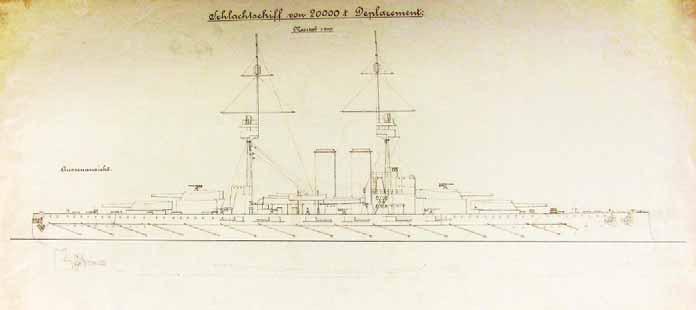The Koudelka-mission During the design process of the future Tegetthoff class, an interesting and unprecedented episode occurred: the Austro-Hungarian Navy asked the permission of its great ally, the German Kaiserliche Kriegsmarine, to obtain information about the newest trends in German battleship design. On 17 April 1909, little after the first draft designs of the future dreadnoughts had been completed Montecuccoli sent a letter via the Austro-Hungarian Military Attaché in Berlin, Karl von Bienereth to Admiral Alfred von Tirpitz, the head of the German Reichsmarineamt, asking his permission for an Austro-Hungarian naval officer to gather information in strict confidence on the new German battleships then under construction.122 The Marinekommandant referred to the intention of the k. u. k. Kriegsmarine to build 20,000 ton battleships, and he explained his request with the need for the possible quickest decision on the armament of these battleships. The permission from Berlin arrived on 25 April 1909. Kaiser Wilhelm II personally gave the permission to the Reichsmarineamt to share confidential information on the newest German battleships with the Austro-Hungarian ally. Montecuccoli chose his secretary, Fregattenkapitän Alfred von Koudelka for the mission. Koudelka left for Berlin on 28 April and arrived back to Vienna on 1 May. Koudelka was received by Konteradmiral Gustav von Bachmann who introduced him to Tirpitz. Tirpitz made a conversation of two hours with Koudelka, who after leaving the Admiral’s office visited the departments of the Reichsmarineamt escorted by Kapitänleutnant Wernher von Rheinbaben, adjutant of Tirpitz. The British were also interested in the Austro-Hungarian battleship projects, so a British spy followed Koudelka during his visit in Berlin. According to Koudelka, on the morning of 29 April, Tirpitz showed Koudelka the British spy out on the street from the window of his office and asked Koudelka not to wear his uniform.123 On this same day, Tirpitz told Koudelka that the leading principle of the German battleship design was the supremacy of the survivability.124 For this reason German battleships had the maximum possible belt armor and a carefully tested underwater protective system. Tirpitz also advocated for retaining the
24 Koudelka’s sketch of the torpedo protection system of the German Kaiser class
15 cm secondary battery under casemate armor in contrast to British practice which, under the guidance of Admiral Fisher, used smaller calibers125. Koudelka had the opportunity of examining the plans of the German dreadnoughts and even given permission to make some sketches to copy details. On the next day he continued the examination of the battleship plans and Geheimrat Veit showed him the four meters-long cutaway model of the dreadnought Nassau.126 Before departing to Vienna, Koudelka briefly met Tirpitz again and gratefully thanked him for the precious information that he had been given.127 In his secret report Koudelka gave an account of the results of the German gunnery and underwater explosion tests. From 1906, the Germans, who had recognized the importance of survivability as one of the lessons from the Russo-Japanese War, conducted careful and expensive tests. The gunnery tests were carried out on old armored ships and on full scale sections representing the dreadnought Nassau, the latter being conducted on the Krupp’s artillery test ground of Meppen. They observed that hits on the sections caused flames “as high as a building” as projectiles passed through coal bunkers, pulverizing and igniting coal. In Tirpitz’s view
— 57 —






























